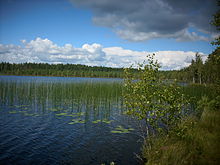Latgale
Latgale ( Latgalian Latgola , Latvian Latgale , Polish Latgalia , Russian Латгалия is) one of the four historic landscapes of Latvia and a region with a distinct multicultural character. It includes the inland southeastern part of the country bordering on Russia and Belarus , in which, besides the Latgals, traditionally Jews , Poles , Lithuanians , Belarusians and Russian Old Believers live. By Latgale flows Daugava ( German Daugava ), as well as the landscape is rich in lakes .
history
Latgale is the part of Livonia that did not become part of Sweden through the Treaty of Altmark in 1629 , but remained under Polish sovereignty. It was therefore also called Polish Livonia earlier . With the first partition of Poland in 1772, Latgale fell to the Russian Empire . From 1802 Latgale belonged to the Vitebsk Governorate .
Unlike in other parts of Latvia who played Germans only in the city of Daugavpils a significant role (Daugavpils). Therefore, the Reformation was only able to prevail here in part, or was pushed back again by the Counter-Reformation under Polish rule, so that the inhabitants of Latgale - unlike their compatriots in the other Latvian parts of the country - are still mostly Catholics and have their own regional language, the Latgalian , speak. In some cases, the Latgals consider themselves an ethnic group that is independent of the Latvians .
The majority of the urban population of Latgale had been Jewish for centuries. For example, according to the 1897 census, 54% of the residents of Rēzekne (German Rositten ) and Ludza (German Ludsen ) were Jews. In the largest city in Latgale, in Daugavpils (German: Dünaburg ), the Jewish population was 46%. There were once around 40 synagogues and Jewish prayer houses in Daugavpils . After the massive destruction of World War II and the almost complete annihilation of the Jewish population, only one synagogue remained.
Today the Russian population is relatively high (regionally up to 80%), especially in and around Daugavpils. Latgale also has a not inconsiderable Polish-speaking minority as a result of the long Polish rule.
Cities
- Balvi (German Bolwen )
- Dagda (German Dagden )
- Daugavpils (German Dünaburg )
- Kārsava (German Karsau )
- Krāslava (German Kreslau )
- Ludza (German Ludsen )
- Preiļi (German Prely )
- Rēzekne (German Rositten )
- Varakļāni (German Warkelen )
- Viļaka (German Marienhausen )
- Viļāni (German Welonen )
- Zilupe (German Rosenau )
literature
Regional studies
- Henriks Soms (ed.): Regional Identity of Latgale (= Humanities and social sciences, Latvia; 3 (36), 2002), Riga 2002.
- Edgars Cakuls: Latgale - the unknown south-east of Latvia . In: East-West. European perspectives . Vol. 10 (2009). ISSN 1439-2089 . Pp. 44-50.
Latgalian history
- Erik Amburger : The governorate Vitebsk and Latgale in the Russian Empire . In: Inge Auerbach, Andreas Hillgruber , Gottfried Schramm (eds.): Fields and forefields of Russian history. Studies in honor of Peter Scheibert . Rombach, Freiburg 1985, ISBN 3-7930-9038-8 , pp. 94-110.
- Bogusław Dybaś: Polish Livonia (Latgale) in the 18th century. A country between states and nations . In: Michael Schwidtal (Ed.): The Baltic States in the mirror of German literature. Carl Gustav Jochmann and Garlieb Merkel. Contributions to the International Symposium in Riga from September 18 to 21, 1996 on the cultural relations between Baltic States and Germans . Heidelberg 2001. ISBN 3-8253-1216-X . Pp. 241-246.
- Norbert Angermann: The Russian rule in eastern and central Livonia 1654-1667 . In: Bernhart Jähnig (Ed.): From the history of Old Livonia. Festschrift for Heinz von zur Mühlen on his 90th birthday . Münster 2004 (= writings of the Baltic Historical Commission, vol. 12). ISBN 3-8258-8066-4 . Pp. 351-367.
- Geoffrey Swain: Between Stalin and Hitler. Class War and Race War on the Dvina 1940-1946 . London 2004.
- Tilman Plath: The Latgale region of Latgale under German occupation 1941 to 1944. Reactions of the population . In: Sebastian Lehmann (Ed.): Reichskommissariat Ostland. Crime scene and souvenir . Ferdinand Schönigh, Paderborn 2012. ISBN 978-3-506-77188-9 . Pp. 101-115.
- Valentīns Lukaševičs, Inta Vingre: " Germanness " in the Latgale region . In: Dirk Baldes, Inta Vingre (ed.): German-Baltic culture transfer . Daugavpils Universitātes Akadēmiskais Apgāds Saule, Daugavpils 2013, ISBN 978-9984-14-655-3 , pp. 107-115.
Latgalian history of religion
- Ernst Benz : Between denominational, regional and national identity. The Catholics in Latgale and Latvia in the 19th and 20th centuries . In: Nordost-Archiv , Vol. 7 (1998), pp. 443–495.
- Inge Lukšaite: Reformation and Counter-Reformation in their historical significance for Lithuania, Latgale and Courland . In: Carsten Goehrke (ed.): The Baltic States at the intersection of developments: past and present (= texts and studies of the department for cultural studies, vol. 4). Schwabe, Basel 2002, ISBN 3-7965-1937-7 , pp. 59–73.
Jewish-Latgalian history
- Mendel Bobe (Ed.): The Jews in Latvia . Tel Aviv 1971.
- Josifs Šteimans: Latgales ebreju vēstures historiogrāfija . Latgales Kultūras centra izdevniecība, Rēzekne 2000.
Footnotes
- ↑ Reinhard Wittram: Baltic history. The Baltic countries of Livonia, Estonia, Courland 1180–1918 . Scientific Book Society, Darmstadt 1973. ISBN 3-534-06475-5 . P. 87.


